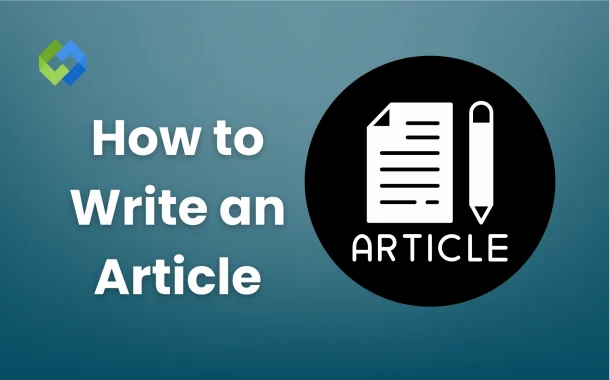In this blog, we will enlighten you with the nine steps to craft an outstanding article.
Surely, they will help you take your article writing game to the next level.
Table of Contents
Table of Contents
1. Understand Your Audience
Before you write a single word, ask, “Who am I writing for?” It’s the most crucial thing in article writing. Skip this, and your article’s already halfway to failure.
Remember, writing for everyone means connecting with no one. That’s why successful content creators always write for a specific audience. Most importantly, they should know exactly who their readers are.
For this purpose, start by gathering real data about your readers. Read the comment sections of similar blogs, use online audience analysis tools to see what your audience reads, listens to, and shares. Moreover, analyze Quora threads and Reddit posts in your niche and look for common pain points, patterns, and language.
Once you know who you are talking to, everything else falls into place, including tone, structure, and word choice.
2. Choose a Relevant and Unique Topic
Now that you know your audience, don’t just give them what’s trending. Instead, provide them with something they haven’t seen or they actually want to read. However, that doesn’t mean you pick a totally irrelevant topic. It means adding a fresh twist to what already exists.
Instead of “How to Save Money,” try “How Developers at Stripe Cut Cloud Costs by 40%.” One’s forgettable. The other makes people curious.
You can also use tools like AnswerThePublic or Google Trends to find the most relevant topics and see different angles. Moreover, you can even utilize Google’s auto-suggestion feature.
Lastly, analyze your competitors’ content. If everyone’s saying the same thing, don’t echo it. Instead, challenge it, expand it, or bring in a story that hasn’t been told.
3. Research Thoroughly
An article without research is just an opinion piece in disguise. Solid research always separates good content from forgettable filler. Therefore, never compromise on research.
However, don’t just pick information from random and unreliable sources when it comes to research. Instead, collect data from credible sources, including books, research articles, academic studies, well-reputed publications, etc.
Additionally, search academic databases, check industry reports, and follow subject-matter experts on LinkedIn and X (Twitter). Keep a running doc of insights, quotes, and data points.
This way, you not only find insights about the topic but also reflect that you have done your homework. It builds credibility, trust, and authority of your work and yourself as a writer.
4. Craft a Captivating Headline
The next step is to create a compelling headline. If your headline doesn’t spark curiosity or promise value, most readers won’t want to read it at all. Remember, people scroll fast, and they judge content from their headlines. If your headline or title is attractive, they will click on it and want to know what you have written.
However, to catch people’s attention, never use the clickbait technique. It will ruin your credibility, and visitors won’t trust you again.
Here are some helpful techniques to write powerful headlines;
- Offer benefits.
- Hit the pain points of readers.
- Use numbers.
- Be concise and direct.
- Ask a question.
- Use power words.
- Try writing 5–10 headline variations before picking one.
5. Structure for Readability
Your article’s overall structure matters a lot. If it’s messy, readers will press the back button and won’t finish reading the entire content. So, use a clear, understandable, and well-optimized content structure. Make sure to provide a smooth reading experience. If you’re drafting with AI, tools like AI Undetect can help ensure the output feels natural and well-structured for readers.
To create a readable content structure, try these techniques;
- Use short paragraphs.
- Break long ideas into bullet points.
- Add subheads every few scrolls.
- Use bold for key takeaways.
- Follow a logical flow.
6. Write with Clarity and Engagement
Clear writing wins every single time. So, don’t try to showcase your vocabulary knowledge or creative skills (unless required). Instead, use strong verbs, simple words, natural phrasing, and cut filler phrases like “in order to,” “due to the fact that,” or “needless to say.” Say what you mean in simple words.
But don’t let simplicity kill the voice. Instead, balance clarity with style. Also, throw in a short, punchy line. Ask a question. Use rhythm. And change up sentence length.
For example;
Instead of: “Businesses are increasingly seeing the importance of streamlining communication workflows to improve efficiency.”
Try: “Teams waste hours on messy communication. Fix it. Fast.”
It’s simple, direct, and more impactful.
7. Optimize for SEO
If you really want your articles to stand out, you must pay attention to SEO and perfectly optimize your content for search engines. SEO isn’t just stuffing keywords; it’s helping the right people find your article.
To optimize your content, start with an intent. Ask yourself: “What would someone type into Google to find your post?” Use that as your primary keyword. Then, naturally weave in related terms in your text.
Moreover, implement a few of these techniques.
- Write descriptive URLs (e.g., /write-better-articles)
- Craft keyword-rich H2s and H3s
- Create meta descriptions that compel clicks
- Add alt text to images
- Create internal links to related articles
However, when writing, don’t just write for search engines. Instead, write for humans. Then, refine for search engines.
8. Edit and Proofread Thoroughly
This is where good becomes great. First, don’t edit as you write. It kills the flow, and you might forget what you wanted to write. Get the draft out. Then go through it with a cold eye.
While proofreading, cut every sentence that doesn’t add value, reword the awkward phrases, and watch out for repetition and filler words. Moreover, use an advanced grammar checker to find and remove all basic to advanced grammar mistakes.
9. Deliver High-Quality, Original Content
Here’s the harsh truth: most of the online content is forgettable. Do you know why? Because it says nothing new. If anyone could have written your article, it’s not worth publishing.
To stand out in the crowd, always bring original thoughts, add data, share a personal anecdote, and include something that only you could write.
Additionally, make sure the entire text is unique and plagiarism-free. Google doesn’t like copied or stolen content. It always values the original content. Therefore, write every word yourself.
Even after that, check copied content to find accidental plagiarism, spot all similar instances in your text, and allow you to remove them before you publish your content.
Conclusion
Writing standout articles isn’t about perfection. It’s about intention. You don’t need a journalism degree or decades of experience to craft an impressive article. But you must care enough to dig deeper, write sharper, edit tighter, and share something real.
If you follow these nine steps, your article won’t just exist online. It’ll matter. And people will read it, link to it, and share it with others. Also, they can even come back to your website for more.














